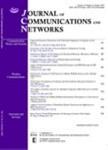版权所有:内蒙古大学图书馆 技术提供:维普资讯• 智图
内蒙古自治区呼和浩特市赛罕区大学西街235号 邮编: 010021

作者机构:Univ Nebraska Peter Kiewit Inst Informat Sci Technol & Engn Dept Elect & Comp Engn Lincoln NE 68583 USA
出 版 物:《JOURNAL OF COMMUNICATIONS AND NETWORKS》 (通讯与网络杂志)
年 卷 期:2004年第6卷第1期
页 面:9-18页
核心收录:
学科分类:0810[工学-信息与通信工程] 0809[工学-电子科学与技术(可授工学、理学学位)] 08[工学] 0812[工学-计算机科学与技术(可授工学、理学学位)]
主 题:spread spectrum CDMA multiuser detection random sequence turbo coding
摘 要:Self-encoded multiple access (SEMA) is a unique realization of random spread spectrum. As the term implies, the spreading code is obtained from the random digital information source instead of the traditional pseudo noise (PN) code generators. The time-varying random codes can provide additional security in wireless communications. Multi-rate transmissions or multi-level grade of services are also easily implementable in SEMA. In this paper, we analyze the performance of SEMA in additive white Gaussian noise (AWGN) channels and Rayleigh fading channels. Differential encoding eliminates the BER effect of error propagations due to receiver detection errors. The performance of SEMA approaches the random spread spectrum discussed in literature at high signal to noise ratios. For performance improvement, we employ multiuser detection and Turbo coding. We consider a downlink synchronous system such as base station to mobile communication though the analysis can be extended to uplink communications.